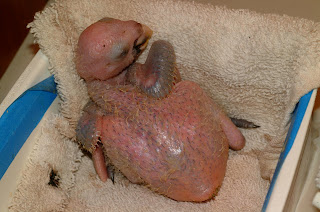
Eva Kennedy - Intern 2008
“There are thirteen African Mountain Bongo around you right now, so please keep your lights off, stay quiet, and follow my golf cart to your cabin.”
As I tentatively followed Paul and Karen into the night, contradicting feelings of excitement, relief and apprehension fell over me. Excitement – I had finally reached the long-awaited tropical destination in southern Florida with promises of caring for beautiful, rare animals, not to mention enjoying the palm tree lined beaches… Relief – I could finally escape the car that had held me captive during the 10-hour drive from Atlanta… and of course… Apprehension – not only was I blindly following a small cart down a dimly lit dirt road but also, it was apparently sandwiched between two groups of graceful but deadly antelope weighing in at over 700 pounds each.
Regardless, once Paul and Karen introduced me to my cozy cabin living space, the month of interning at the Rare Species Conservatory Foundation held greater promise than ever. I did always love a challenge and after working with brown capuchin monkeys for the last 3 years, I eagerly awaited the opportunity to gain experience with a greater variety of species… no matter how intimidating or mysterious.
Currently, I am entering senior year at Emory University in Atlanta and am majoring in psychology (with a focus in animal behavior and primatology). I am also pursuing a minor in visual art. I have been working with Frans de Waal in his Living Links capuchin lab at the Yerkes National Primate Research Center and have traveled to Africa with one of the RSCF board members, Richard Estes. Dr. Estes is not only the leading expert on Wildebeest, but he knows more about nearly every African mammal than anyone I have encountered thus far. It is people such as him, and Paul – who can perform surgery, hand-raise a baby parrot, and then erect a building – that make RSCF such a diverse and enriching community. Volunteering at the Conservatory provided me with invaluable experiences in habitat maintenance, behind-the-scenes visits to the surrounding animal parks (such as Lion Country Safari and the Palm Beach Zoo), access to talented and experienced professionals (like RSCF board member and veterinary, Mark Davis), the experience of caring for and raising exotic species, while also provoking a heightened consideration of the economic aspects of environmental design and of other problems facing modern conservation efforts in both the United States and around the world.
When I reflect upon my first impressions of the Rare Species Conservatory, they invoke both laughter and emotion. From going through the daily motions of feeding the numerous Amazonian parrots, Pygmy Marmosets, Golden Lion Tamarins, and African Bongo, to pulling high-tensile fences and digging up invasive plant species (such as Brazilian Pepper trees and potato vines), volunteering at RSCF provided a multifaceted experience in animal care and conservation. At the Conservatory, you quickly learn that nothing builds teamwork like “pokey-sticking” ten-foot wooden fence posts into the ground during the midday August heat in south Florida. I gained the essential hands-on experience necessary in creating successful animal habitats and received unique insight into the breeding and conservation techniques for multiple rare animal species. Rare Species shows that even a small organization can lead the way in saving an endangered species.
I thank Paul, Karen, Dick, and the rest of the board, as well as Rose, Justin, Kevin, and Anita on the RSCF staff, for welcoming me into their impressive organization and illustrating the dedication and determination involved in the preservation of our planet’s species.



